In short a small cap is not enough to protect the input from along wire with ESD exposure.
Suppressing a slow clock is not sufficient to detect a touch. Better put 10k in series with CMOS input if you expect some nasty 10k-25k V ESD to limit the current to a few mA.
Discharge protection requires a large series resistance and Ohms Law on ESD diode protection current is also affected by reactive impedance. Essentially a simple solution is using along wire, picks up lots of stray 60Hz instead of a 10Hz clock. which can be attentuated by the body, hand or finger to ground via a series resistance of 10k to shunt the signal and limit the ESD current into the protection diodes to the CMOS rails. switch normally open with the hand lower impdance to shunt the signal. If the knob cannot be grounded, then a pullup resistor with a series R for protection to inject.60KHz and clamp ESD will detect finger touch. 300pF is 10M near 60Hz.
Addittional info
You want your system to work under any condition, without any environmental restrictions or limits to tribolelectric generation. . Plan on at least +/-25kV and those devices rated for ESD use a smaller model for finger capacitance for discharge. You want it protected for Hotel Room arcs of an inch with Neoprene shoes walking over Nylon carpets, which can can easily generate a good 1" arc, which is roughly 25mm and at low humidity works out to be around 25kV or 1kV/mm.
Impedance
Capacitance and leakage resistance tend to be inversely related with contact area and skin moisture content.
Contact thru the tip of a resistor wire can be 300pF and 300kOhm. A finger tip to a knob can be 3nF and 30k while the whole hand on a metal door knob can be >30nF and <3k. But the discharge time is controlled by the ESR or effective series resistance of your body & skin when ionized air penetrates your dry skin to the sub-cutaneous level into the blood vesels and can be ~ few hundred Ohms, rather than 5k~500k. This results in picosecond rise time discharges.
Your skin may differ by more than an order of magnitude, but my RC time is around 30nF*3k ~=100us using a 1kHz LRC meter, which coincidentally is the time constant of most scope probes. Many amps of current by the finger can be delivered from a tiny arc but in a very short time. The shortest times are well below sensing by humans but can still damage semiconductors.
